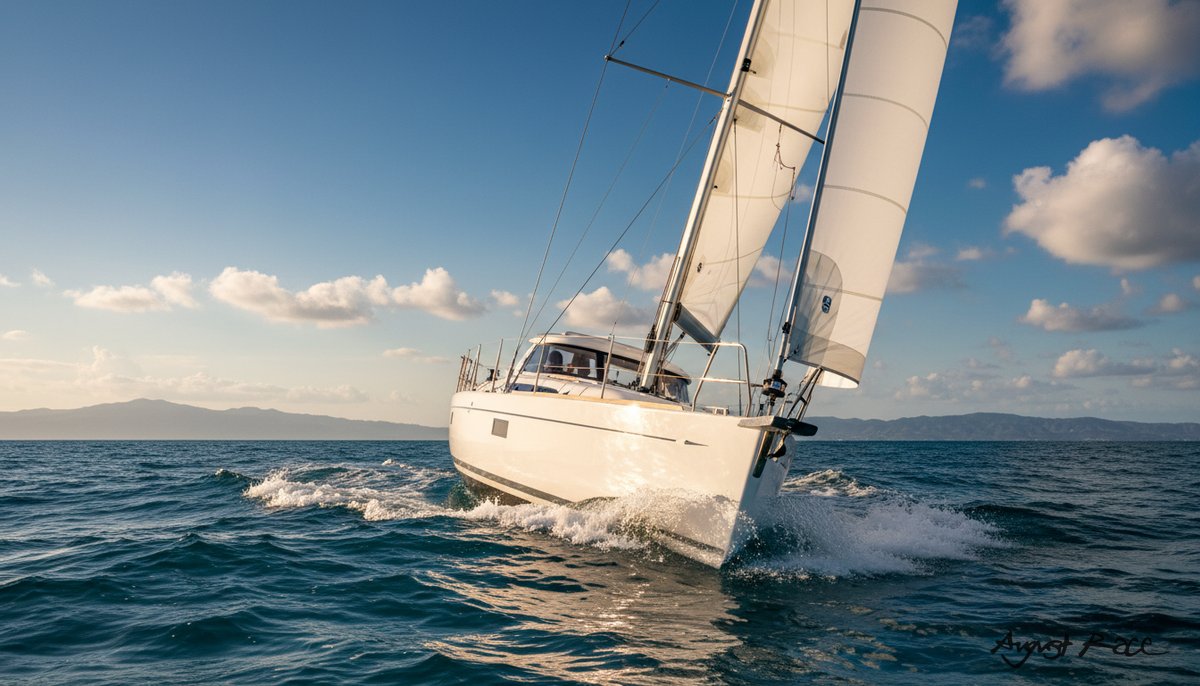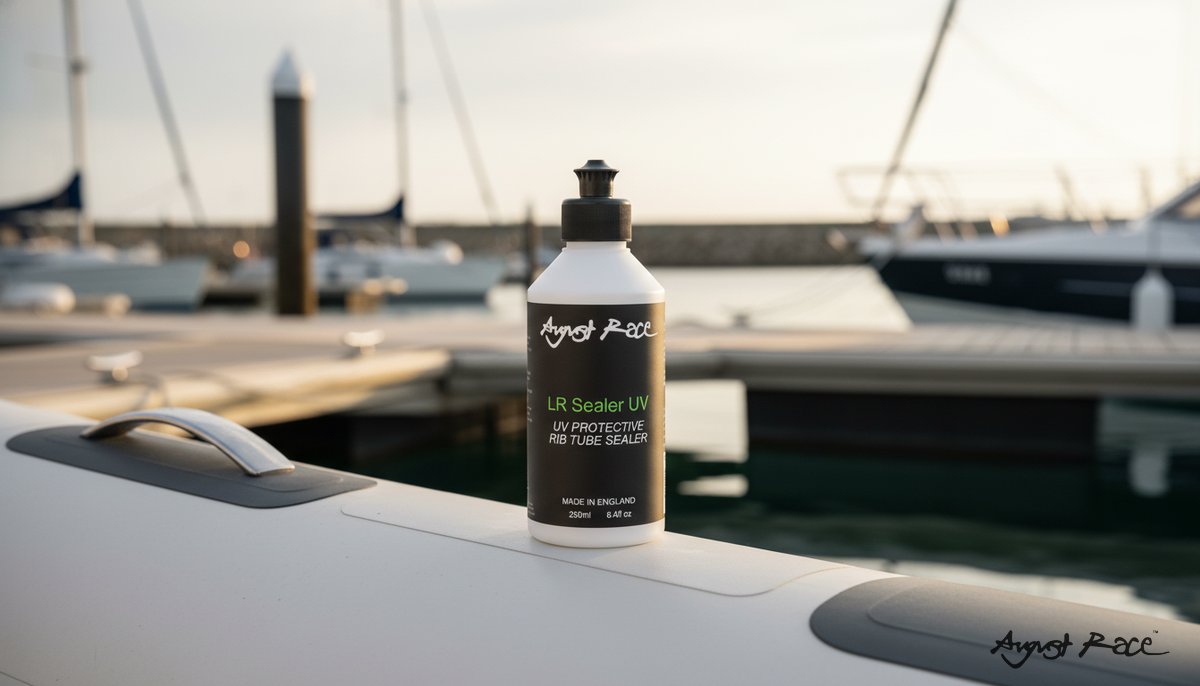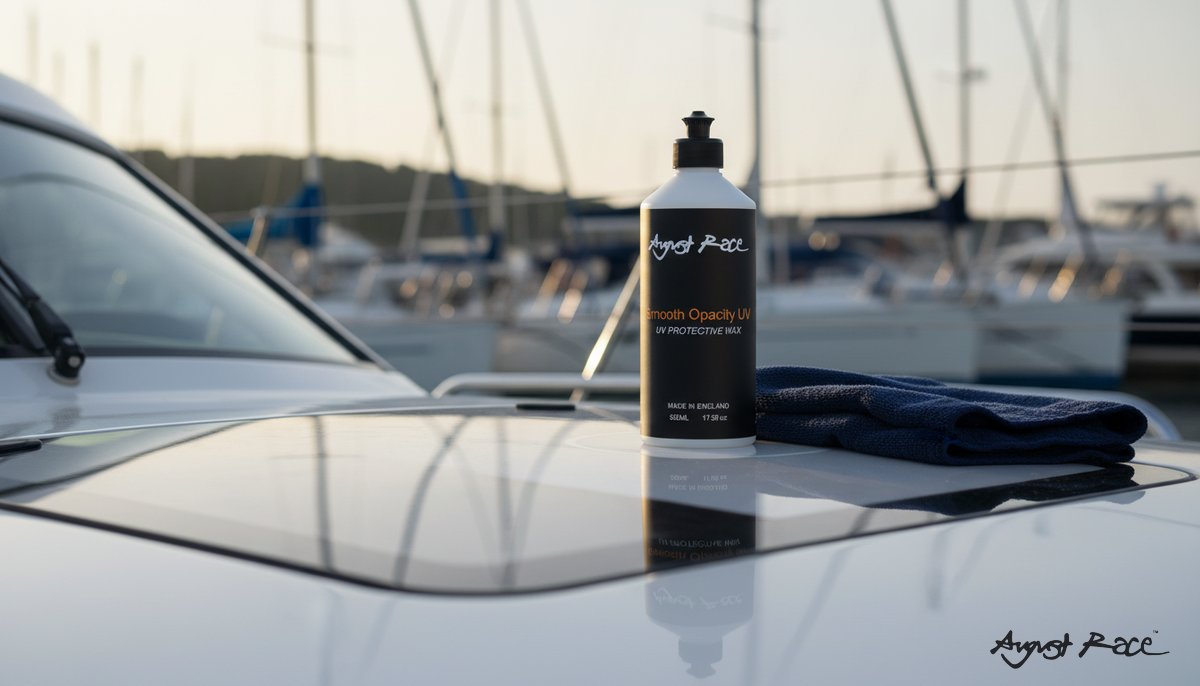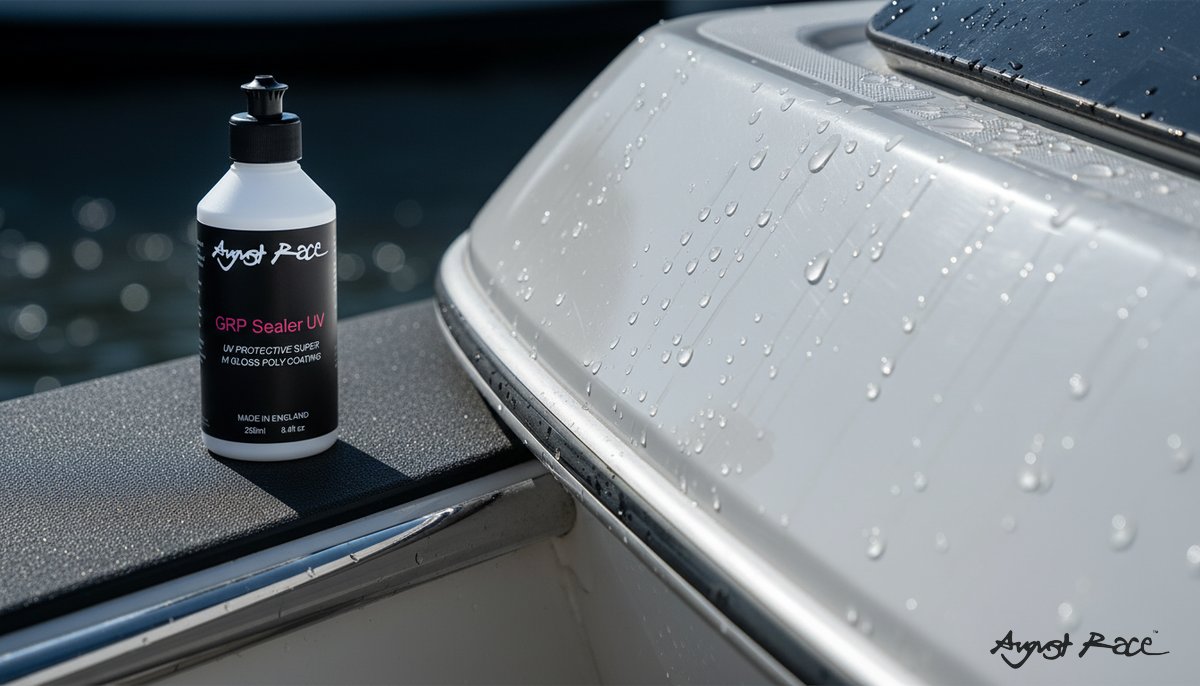Streamline Fleet Care with August Race GRP Sealer UV: Scalable UV Protection for Marina Managers
A busy morning at our marina starts before sunrise. As we walk the pontoons, we check lines, safety gear, and the general look of our berths. What catches the eye most is the inconsistency across fiberglass: some hulls pop with a hi-gloss finish, others show dull patches, water-spotting, and early fade. For a facility that prides itself on standards, uneven presentation becomes a source of complaints, callbacks, and extra detailing. We need a GRP sealer and a process that works as well for a 22-foot runabout as it does for a 60-foot charter yacht.
We’ve seen how sun, salt, and traffic wear down surfaces, and we’ve felt the cost in our rotas and budgets. UV protection fiberglass is not a nice-to-have. It’s fundamental to protecting gelcoat, limiting micro-oxidation, and avoiding rework. That’s why, during a recent facility audit focused on throughput and presentation, August Race GRP Sealer UV stood out -- purpose-built for GRP, designed to seal fiberglass from UV, and straightforward to implement across multiple boats and teams.
A morning at the marina: why consistent GRP care matters
First light is a harsh critic. Under a low sun, every swirl mark and chalky patch shows. Inconsistent finishes don’t just look bad; they knock time off our day. One owner notices a faded transom and asks for a rush polish. A charter operator expects “showroom-ready” and pushes for a discount when the gloss is uneven. Each exception breaks our schedule and forces our crew to split focus.
The root cause is usually the same: UV has been eating at the gelcoat week after week. Across dozens or hundreds of visiting yachts, tiny lapses scale into hours of rework and higher materials spend. We need a fleet-level answer -- something we can deploy predictably so every vessel leaves our berths looking consistently sharp.
That’s where August Race GRP Sealer UV entered our plan: a GRP sealer we could plug into our SOPs to raise presentation standards while cutting repetitive polishing.
The operational challenge: UV, wear, and the hidden costs of inconsistent finishes
UV exposure accelerates fading and micro-oxidation on gelcoat, especially on exposed GRP topsides, cabins, and hardtops. High-traffic charter boats compound the problem: frequent washdowns plus sun-bleaching lead to patchy, dull areas that build up over a season. Without a protective layer to seal fiberglass from UV, visual quality drifts fast.
Operationally, inconsistency is expensive. If crews are constantly spot-correcting individual vessels, schedules fragment. Team leads juggle ad-hoc polishing, slip movements, and drying windows. Instead of a fleet-wide program, we end up firefighting boat by boat.
Customer experience suffers too. When our visiting yachts don’t look uniformly glossy, perceived value dips. We field more complaints, and booking confidence lags -- especially with repeat charters comparing this week’s boat to last month’s.
Budget-wise, small issues grow. Unprotected fiberglass can escalate from light oxidation to heavier correction, burning hours and compounds. The smarter route is to reduce fiberglass maintenance by building UV protection into our routine, not stacking more corrective work on the back end.
What August Race GRP Sealer UV brings to a marina manager’s toolkit
August Race GRP Sealer UV is a poly-coating formulated specifically for GRP surfaces. At a glance, it’s designed to deliver a durable, hi-gloss finish while adding UV blockers that slow surface degradation. For our purposes, that means better day-to-day appearance and fewer deep correction cycles.
Here’s how it fits our operations:
- Purpose-built for GRP: The poly-coating bonds to gelcoat to enhance gloss and provide a sacrificial layer. Instead of relying on repeated compounding, we preserve finish between detailing cycles.
- UV-focused protection: The formulation is engineered to support UV protection fiberglass surfaces need in open berths and high-sun regions. That helps maintain colour depth and surface clarity.
- Throughput-minded application: Crews can work in zones (hull sides, topsides, superstructure) to keep boats moving through the day. We plan boat counts per shift using the manufacturer’s coverage guidance and the cure/flash-off windows on the label. This lets us treat multiple vessels without bottlenecks.
- Compatibility: It’s suitable for common gelcoats. As with any sealer, we spot-test a discrete area first, especially on older or previously restored sections, to confirm bonding and sheen.
- Less frequent heavy polishing: By locking in a hi-gloss finish, we reduce how often we need aggressive compounds. That lowers materials use and preserves gelcoat thickness over time.
- Safe handling and storage: Product handling aligns with typical marina SOPs -- clean, ventilated workspaces; PPE per the SDS; and labeled storage away from ignition sources. We track lot numbers and expiry dates to keep inventory tight.
Operationally, the win is consistency. One product, one method, repeatable across boats. We’ve built it into our seasonal prep so we can schedule sealing in off-peak windows and keep high-traffic vessels on a predictable maintenance cadence.
Scaling quality: fleet workflows and workforce tips for consistent results
When scaling a poly-coating program across a fleet, process is everything. The following workflow has helped our teams deliver uniform results across sizes and hull forms.
Step-by-step workflow
- Pre-clean and decontaminate
- Rinse and wash with a pH-neutral cleaner such as August Race Boat Wash Pro.
- Remove salt, grease, and fallout. Use a mild decon if needed.
- Dry thoroughly to avoid trapping moisture.
- Inspect and mask
- Mark oxidation or scratch areas for light correction before sealing.
- Mask rub rails, fittings, decals, and non-skid.
- Prepare staging (fenders, scaffolds, or dock position) to keep crews safe and efficient.
- Light correction (if needed)
- Spot-correct with a fine polish on dull patches to level out the finish.
- Wipe down with a clean, lint-free cloth to remove residues.
- Application technique
- Follow the label for pad/cloth choice and coverage. Work in small, controlled sections.
- Maintain thin, even layers. Over-application wastes product and extends cure.
- Cross-hatch passes for uniform coverage.
- Drying and cure windows
- Observe the recommended flash-off and cure times from the manufacturer.
- Control dust and overspray by working leeward and limiting traffic around the boat.
- Plan staging so another team can prep the next vessel while the first cures.
- Inspection checkpoints
- Use LED inspection lights at a low angle to spot high/low areas.
- Sign off by section, not by boat, to catch misses early.
Crew training and consistency
- Standardize checklists: Pre-clean, mask, apply, cure, inspect, sign-off.
- Batch scheduling: Group boats by size and exposure so crews repeat similar motions and timing.
- Role clarity: Assign a lead per boat who owns the final gloss check.
- Tooling: Dedicate labeled pads and cloths per vessel to minimize cross-contamination.
Timing and frequency guidance
- Exposure-based cadence: Reapply more frequently for bow-in south-facing berths and for boats with high charter turnover.
- Seasonal anchors: Integrate sealing into pre-season commissioning and mid-season refresh to maintain long-lasting boat shine.
- Local UV index: In high UV regions, plan shorter intervals; where sun is less intense, extend between applications. Use meter readings or local forecasts to guide intervals.
Equipment and staging for speed
- Two-lane workflow: One lane for prep/correction, one for seal/coating and cure.
- Color-coded caddies: Keep pads, cloths, and tape organized by task.
- Spill control and waste: Dedicated bins for used pads and cloths; keep decks clutter-free.
With clear SOPs, the program scales easily. Our teams know the sequence, we forecast time per boat, and we keep the marina moving.
Evidence from the docks: results, durability, and appearance over time
We track presentation because guests notice it first. After adopting a sealer-based program, our crews reported fewer polishing touch-ups between charters and more consistent reflections along hull sides. On high-exposure berths, the gloss held up better through peak sun weeks, with less chalking on cabin tops.
Field feedback also matters. Owners and charter managers have commented on the “freshly-detailed” look that lasts beyond the first week after turnover. That perceived value shows up in smoother handovers and fewer requests for last-minute buffing.
From a maintenance standpoint, we’ve seen a shift from corrective to preventive. With a protective layer supporting UV protection fiberglass needs, routine washdowns restore gloss quickly, and we spend fewer hours on heavy correction. Material use trends down as we reduce aggressive compounds in favor of a consistent sealing schedule.
As always, results reflect prep quality, application discipline, and local conditions. But the direction is clear: a structured sealing program supports durable appearance and steadier workloads.
Addressing common concerns: compatibility, environmental impact, and cost per berth
Compatibility
- Works with common gelcoats; we always spot-test a discreet area, especially on older or previously restored sections.
- Avoid applying over unremoved oxidization or wax residues. Clean, correct, then seal.
Environmental considerations
- For those prioritizing an eco GRP sealer approach, start with disciplined dosing, cloth management, and spill controls.
- Check the product’s SDS for VOC content and follow local marina and harbor regulations for use and disposal.
- Store sealed containers properly and keep application areas ventilated. Dispose of used pads and cloths per local guidance.
Cost-per-berth model
- Direct costs: product, pads/cloths, and crew hours to apply.
- Savings: fewer heavy compounding cycles, reduced polish usage, and faster turnarounds.
- Simple approach: compare a season of routine polishing alone vs. scheduled sealing plus light maintenance. Use the manufacturer’s coverage guidance and your crew hourly rates to model ROI. Many facilities find sealing reduces fiberglass maintenance hours over the season.
Scheduling in peak season
- Use off-peak windows (midweek, early morning, or shoulder season) for full applications.
- Prioritize high-visibility and high-turnover vessels first.
- Keep a standby plan for weather: tents or indoor bays for consistent cure when possible.
Pilot plan and next steps for a marina-wide seal program
We recommend a low-risk pilot before a full roll-out. Choose 3–5 representative vessels -- mix sizes, hull colours, and exposure levels -- to prove fit, finish, and workflow.
Action checklist
- Order sample kits of August Race GRP Sealer UV.
- Run a half-day training: prep standards, application technique, inspection, and sign-off.
- Apply to pilot boats, documenting pre- and post-appearance with photos and gloss readings (if available).
- Track labor: prep time, application time, and any rework.
Success criteria
- Appearance: consistent, hi-gloss finish visible from dock level.
- Durability: acceptable gloss retention through the trial period under typical washdowns.
- Efficiency: a measurable reduction in corrective polishing hours and smoother turnarounds.
- Owner/guest feedback: fewer presentation complaints; positive remarks on finish.
Next step: Coordinate with procurement to schedule a product demo or request pilot quantities from the August Race shop. If the pilot meets standards, add the GRP sealer to your seasonal SOP and forecast product needs by berth count and exposure.
Bottom line
For a marina juggling presentation and throughput, a structured sealing program pays off. By building August Race GRP Sealer UV into our SOPs, we seal fiberglass from UV, preserve a hi-gloss finish, and reduce fiberglass maintenance across the fleet. The result is steadier schedules, sharper-looking boats, and a consistent standard our guests notice.
FAQs
How does August Race GRP Sealer UV help seal fiberglass from UV exposure for visiting yachts?
It applies as a protective poly-coating over GRP, adding UV-focused blockers that help slow surface degradation. This layer preserves gloss between washdowns and reduces the need for aggressive correction, especially on sun-exposed areas.
What is the recommended application frequency to maintain long-lasting boat shine across a fleet?
Cadence depends on exposure and usage. As a rule of thumb, schedule sealing during pre-season commissioning and plan a mid-season refresh for high-sun or high-turnover vessels; lower-exposure boats can often run longer between applications.
Is August Race GRP Sealer UV an eco-friendly GRP sealer suitable for marina use?
The product is designed for GRP surfaces and can fit an eco-conscious program when handled properly. Review the SDS for VOC and disposal guidance, follow local regulations, and pair it with disciplined dosing, spill control, and proper waste management to keep operations compliant and responsible.
About the Author
August Race Team
The August Race professional team brings decades of marine industry expertise and product development knowledge.
Get Expert Tips
Subscribe for marine care insights and product updates from industry professionals.
No spam. Unsubscribe anytime.
You May Also Like

August Race GRP Sealer UV: Scalable GRP UV Protection
Protect GRP fleet-wide with a biodegradable, hydrophobic fiberglass sealant. Faster washdowns, longer gloss, and scalable SOPs for busy marinas.

RIB UV Protection: How LR Sealer UV Protects Tubes
Guide to RIB UV protection using LR Sealer UV -- PVC tube sealer and Hypalon UV treatment to prevent UV cracking and reduce cleaning.

Smooth Opacity UV: Pro UV Protection Boat Wax Guide
A marine tech’s guide to Smooth Opacity UV -- UV protection boat wax and hydrophobic boat polish for gelcoat. Improve gloss, repel water, and extend service...
